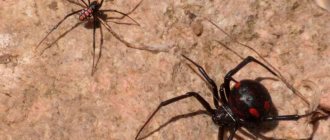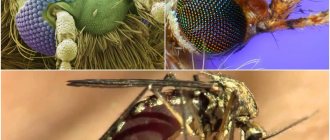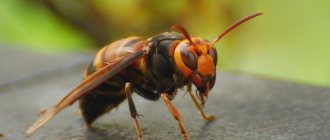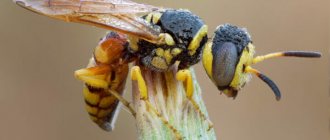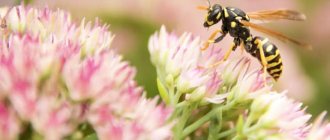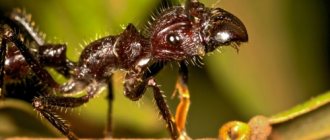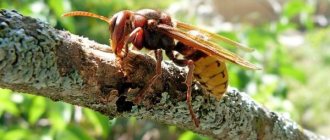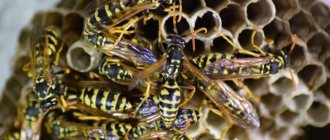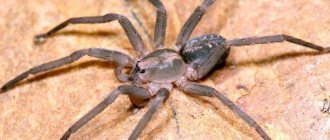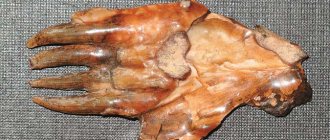In a wasp colony there is a clear division of responsibilities. The most important function is performed by the uterus, which is responsible for raising the offspring. All other individuals help her in this in every possible way.
Scientists identify species of wasps that prefer to live in groups or alone. The first group includes various individuals that live in the same nest. Within their own colony, they are divided not only into females and males, but also into workers and the queen. The latter is also called the queen. At the end of each season, she produces fertile offspring. As for singles, they continue their lineage without outside help. At the same time, they build nests and carefully care for their offspring. There are certain species that may well exist without being tied to a specific home. They prefer to live in the field, and their offspring develop in the ground.
Appearance and anatomy of a wasp
You can find out what this insect looks like from a biology textbook.
Since it is impossible to tell everything about wasps in one article, we should focus on the most common species - the common wasp. These winged insects differ from their relatives in their striped colors. The average body length of the insect is 2-3.5 cm. On the yellow-black back there are four wings, with a pair of hind wings linked to a pair of front wings, which is why it visually seems that there are only two wings.
Interestingly, the size of the wasp depends on the gender of the insect. Females are considered larger, and can reach 5.5 cm in length. Such individuals are found in warm countries with a tropical climate.
The system of visual organs in wasps is no less curious. They have not two, but five eyes, which allows them to get maximum visibility of their surroundings.
In addition to the visual system, multifunctional antennae are of great importance for the life of insects. They play the role of a kind of antennas, being at the same time organs of touch, smell, taste buds and a measuring device.
Interestingly, when building a nest, wasps measure each cell with their whiskers.
The internal structure of wasps is similar to bees. Both Hymenoptera have a sting in the lower part of their abdomen, a thin organ associated with a gland that produces toxic venom. Only females can sting, so males are generally considered harmless.
Nature endowed them with this ability so that they could protect themselves, their offspring and their nest from larger insects (for example, from a hornet).
Development and feeding of larvae
The queen lays her eggs in empty cells to prevent them from falling out; the queen uses a sticky secretion for gluing. Each cell is filled with an egg as construction is completed. The development of the offspring, including several moults, occurs in 2-3 weeks. The larvae are approximately the same length as the adult, but are much thicker. They are all white or yellowish in color and lack legs. Their digestive organs are not adapted to plant foods. The queen, and then the working females, feed them fermented protein foods.
Interesting fact. Small larvae feed on the crop secretions of the uterus.
What do wasps feed their larvae? The diet is wide, it includes various types of insects (flies, butterflies, beetles) and pieces of meat or fish that females find during flights. Carnivorous larvae cannot chew themselves, so they end up with lumps of “minced meat.” The wasps hold a lump of food near the larva's head for 8-10 seconds, the remainder goes to feed the next larva. Having reached a certain stage, the larvae close the cell with a lid and pupate. In a few days a new wasp will appear.
Information. The larvae of hornets and some other types of wasps scratch at their cells when hungry. This sound becomes a signal for working individuals that it is time to go hunting.
Feeding in social wasps is not a one-way process. The larvae regurgitate drops of liquid, which are licked off by the worker insects. This interaction is called traphallaxis. It helps insects exchange information and survive in the absence of food.
Information. Queens often die during the rearing of the first generation of wasps. Left without care, the larvae die of starvation.
Where are wasps found?
Species of wasps that live in families build nests consisting of individual elements called honeycombs. Insects build their nests not far from places where there is a lot of building material and food. Often, abandoned nests, rodent holes, tree hollows, etc. serve as such places for this. It is not so rare for wasps to appear on garden plots or summer cottages, in various outbuildings, in the attics of houses, on balconies, etc. Here they live and raise their offspring throughout the summer, and with the arrival of autumn they leave the nest. Only young, fertilized females survive and find refuge in various places.
Solitary wasps are found exclusively among wildlife. At night, they can be on the stems of various plants, holding onto them with their paws and jaws. They can climb into a flower. These insects behave like nomads, constantly changing their location.
How does the queen winter?
Not all adults that emerge from oviposition in the fall survive until spring. There are several reasons for this:
- Cold;
- Poorly chosen wintering place;
- Predator attacks (mammals and birds);
- Bacterial infections - most often they are picked up by individuals who seek refuge in old nests.
A significant part of the hornets die. Insects that hide for the winter under a thick layer of bark on trees have a greater chance of survival. This is an insurmountable obstacle for birds, and there are no other hornet hunters at this time of year. During wintering, body functions slow down enough for insects to survive without starving to death. During this period, the body is supported by the accumulated supply of nutrients.
Thus, in appearance, the queen hornet resembles a wasp. When a large number of insects accumulate, it is difficult to see the difference, but if you look at a single hornet, you will notice that the bandages on the body are not so pronounced, and the chest is colored brown. However, the main difference is in size.
The queen is well protected in the nest, as she does not fly out of it, but performs only one function - laying eggs. However, it is the female who lays the nest in the spring.
Lifestyle and habitat
Wasps are found in any area. These insects perhaps do not adapt to cold, unsuitable areas for existence. They always live close to humans, thereby providing themselves with constant food. Wide populations of wasps are present in almost all countries of Eurasia, North Africa, Australia, Mexico and Argentina. They are not found except in the Arctic and Antarctica, as well as in deserts.
Representatives of different species tend to build a social hierarchical system. Most wasps live in groups. Insects form close-knit colonies and conduct joint life activities. In some aspen families there are 15-20 thousand individuals. Each colony has a social structure that involves stratification into classes and the definition of responsibilities.
In addition to social ones, there are solitary individuals that do not depend on others and do not have a nest or swarm. These are predatory insects that catch beetles and spiders larger than themselves. They sting victims with their sting and release poison, after which they are paralyzed.
The predominant percentage of colony members are working wasps. They search for food for themselves and the larvae, and protect the nest from attack by other insects. Moreover, such individuals are quite aggressive. If they are slightly disturbed, they will immediately attack, and if they sense a real threat to their home, the entire swarm will fly out.
The danger of uterus bites for humans
The queen flies freely in the spring, when she is looking for a suitable place for the nest, and in the fall, when she leaves it. Spends most of its life in the nest and does not get out. Meetings with the queen occur much less frequently than with working individuals.
The Queen behaves calmly and carefully, because she understands what an important mission is entrusted to her. When meeting a person, it tries to hide unnoticed, rushing to attack only if there is a threat to its own life or its new nest.
The sting of the queen wasp is slightly thicker, so the bite itself is somewhat more painful. Swelling, redness, and swelling immediately appear. Further symptoms depend on the individual characteristics of the body. Symptoms disappear after disinsection of the wound within a week, or special treatment with antihistamines and antiallergic drugs is required.
Sources
- https://VrediteliSOS.ru/nasekomye/skolko-zhivut-osy.html
- https://7ogorod.ru/prochee/matka-osy.html
- https://alt-zem.org/drugoe/kak-vyglyadit-pchelinaya-matka.html
- https://1klop.com/zhizn-matki-osyi-kak-vyiglyadit-osa-koroleva-iv-chem-ee-zadacha
- https://apest.ru/osy/ob-osah/matka-os/
- https://tarakanam.com/nasekomyie-kak-vyiglyadit-matka-os-na-primere-shershnya-i-koroleva-pchel
- https://klopkan.ru/osy/o-matke-osy-kak-vyglyadit-i-zhivet-koroleva-os-razmery-korolevskoy-osobi/
- https://pim7.info/matka-osy-foto-razmer/
- https://beetlestop.ru/matka-osyi/
[collapse]
Reproduction and lifespan
In social individuals, the eggs are laid by the female. Fertilization occurs once in the autumn. A wasp can lay several hundred eggs per day, from which larvae will subsequently hatch and turn into pupae. The last stage of the reproduction cycle is the transition to the adult stage.
After mating, the female begins building a home. She brings insects paralyzed by poison to the nest, and then lays eggs on their abdomen. After this, the female seals the nest for the winter, during which the offspring eats the supplies prepared by the mother. Once the larvae develop into adult wasps and are able to leave the nest on their own, they fly away.
Interesting! Wasps easily find their homes even after flying long distances. But if you move the nest in the absence of insects, they will not be able to find it.
The life expectancy of males and females is different. The first live on average for a couple of weeks. The male dies after mating. Queen wasps live for several months, and in warm countries - for years. They are responsible for choosing a nest site and raising offspring. With the onset of frost, mature wasps die, and young individuals overwinter in the wood.
A bite of an insect
Social wasps attack humans more often than other species. This is due to their nest-protecting instinct and aggressive nature. At the end of spring and beginning of summer, the queen makes many flights, taking care of feeding her offspring. Any actions in her direction may provoke the use of a sting. A wasp sting in a healthy person causes a local reaction characterized by redness and pain. Such manifestations disappear after a few hours, less often days.
The wound must be lubricated with an antiseptic composition - alcohol tincture, iodine, hydrogen peroxide. Pathogenic microorganisms can be carried with the sting. Allergy to uterine wasp venom occurs in 1-2% of people; it manifests itself with varying degrees of severity. This may include hives, dizziness, rapid heartbeat, and swelling of the larynx is especially dangerous. If these symptoms appear, you must take an antihistamine and go to the hospital.
The wasp queen plays a major role in the establishment and development of the colony. This is the only female in the family capable of laying eggs. The loss of the queen leads to the decline of the swarm. Other females can transform a non-functioning ovary into an ovipositor, but due to the lack of sperm they will give birth to exclusively males. Such a family has no chance to continue the family line.
Appearance of the queen wasp
Among the swarm of swarming insects, the queen is distinguished by one feature - its larger size. If working individuals have a body length of 16-18 mm, then it grows to 20-25 mm. The head, chest and abdomen are clearly defined, there is a thin waist, characteristic of all stalked-bellied insects. On the sides of the head are complex compound eyes. The mesh structure of the organ allows you to look in several directions at the same time. The antennae are sensory organs that report on the state of the environment. Strong mandibles (jaws) are adapted for various functions:
- tearing and chewing food;
- gnawing passages;
- preparation of building material for nests.
The wasp's uterus looks the same as other females - she has two pairs of transparent wings and small hairs on her body. At rest, the wings are folded and pressed tightly along the body. Due to the presence of a narrow waist, the insect's body is folded almost in half, this allows it to sting the enemy from any angle. The female's sting is a modified ovipositor; it is connected to a gland that produces poison. Weapons are used against enemies that threaten the colony or queen. For hunting, the queen uses jaws that can gnaw through a strong chitinous shell.
Speaking about the reproduction of social wasps, it should be noted that the size of an insect colony varies significantly depending on their species. Social or paper wasps are divided into several subfamilies, the most common being the Vespins and Polistas.
What does the uterus look like
The queen wasp attracts special attention, since there is no one to compare fertile solitary females with - there are no working individuals. Body length is from 10 to 40 mm, the color is not only striped with a bright black and yellow color. Among the single, primitive representatives of the species there are black, blue, red, green, and purple colors.
The royal wasp of vespins and pollists differs from the working individuals in size. Almost 2/3 longer than their body. If the working individual grows up to 16 mm, the uterus grows up to 25. There are no special differences in the structure or structure of the body. The powerful jaws, which the insect uses for self-defense, hunting, and obtaining building material, stand out noticeably. Powerful mandibles easily gnaw through hard parts of victims if the sting fails to penetrate.
It has long whiskers on its head, allowing it to detect odors from several kilometers away. The head is lowered to the bottom, complex compound eyes are clearly visible on the sides. At the same time, the wasp sees the picture in different directions, the generalized result is displayed in the form of a mosaic. This feature of vision helps to instantly capture moving objects and vibrations of light.
The chest and abdomen are connected by a thin membrane, giving the impression that the body is about to be torn into 2 parts. Thanks to this structure, the insect easily bites from any angle and skillfully pulls the sting back. A photo of the wasp uterus is presented below, where you can examine in detail the color, structure, and evaluate the size in relation to the working individuals.
Wasp uterus
On a note!
The main weapon of the uterus is the sting - a modified ovipositor that connects to the poisonous glands. The insect is injected into the victim's body, paralyzing it in a few seconds. In humans, a toxic substance provokes an allergic reaction of varying intensity.
Single queens
They are active in early spring – the mating season begins. Eggs begin to be laid in summer. Before this, they live for their own pleasure - collecting nectar from plants, drinking juices of fruits and berries. They do not form multi-tiered nests; they dig holes in the ground for laying eggs.
The queen prepares the nest in light, easy-to-digging soil. The depth reaches 5 cm; a single cell is located at the bottom.
Interesting!
The female paralyzes the larvae of large beetles, spiders, and various insects, drags them into a hole, and lays an egg on the body. After a few days, a larva appears and devours the victim within 14 days.
In this way, the queen provides the larva with separate housing and food. At the end of the cycle, pupation occurs. In the pupal state, the larva overwinters; in the spring, young females and males independently emerge to the surface, and the mating process begins.
How to find the queen
You can distinguish a queen bee from a worker bee by their marks. But this is provided that the family was purchased from a nursery. What should a novice beekeeper do at home? How can he find the queen in the hive? To do this you need to know some features of the insect:
- Appearance:
- The queen is the largest bee in the hive, but should not be confused with the drone. The queen bee's abdomen is much longer and narrower, while the drone's is thick and short.
- You need to take a close look at the end of the abdomen, in the sting area. In the queen, this part has a pointed shape, while in the worker bee it is slightly blunt.
- If we look at bees from above, their legs are practically invisible, since they are all located directly under the insect. The queen's paws are spread out to the sides and are clearly visible.
- If there are bees in the hive that are very similar to the reigning lady, and the beekeeper has doubts about where the real queen bee is, then it is enough to carefully lift the insect by the thoracic region and examine its sting under a magnifying glass. This part of the bee's body has serrations. The queen's is smooth.
Queen bee
- Location:
In order to detect the queen, you need to carefully examine each frame and find the larva on it. It is very similar to a rolled caterpillar and is located in a cell of the foundation. The uterus can be located in this place, since it is the only one responsible for laying eggs.
Important! All manipulations with frames must be carried out very carefully and carefully, otherwise you can kill the queen
- Since the monarch bee does not leave the hive and does not move along the edges of the frames, it can be found in the center, provided that the hive is horizontal. In a vertical position, it can be found on the lower frames.
- You should carefully monitor the atmosphere in the hive. If the colony is actively moving and larvae suddenly appear, we can safely assume that the queen bee is nearby.
- Queen bee behavior:
- You should carefully monitor the movement of the bee colony if workers and drones make way for one bee, then return to their original place. This behavior is typical for bees when the royal moves.
- The queen in the hive does nothing other than lay eggs. She doesn't even feed on her own. Therefore, if such an insect comes into view, then this is most likely the object of the beekeeper’s search.
- If a beekeeper notices that bees approach one individual and feed it, then this is most likely the queen bee.
If the search object is found, then it is better to mark it for the future. To do this, it is best to use the above range of colors. The insect must be carefully picked up, while trying not to injure it. During marking, you need to hold the queen above the hive so that she does not accidentally fall into the grass or onto the beekeeper’s things. In this way, you can provoke an attack by the workers who will defend their queen.
You can provoke an attack by working women
A dot is placed in the thoracic region between the wings. But they apply it carefully and in small quantities, otherwise the dried paint will hinder its movements. Sometimes beekeepers practice marking the queen bee by cutting off the tips of the wings.
Vespina
The most organized species of wasps belong to this subfamily. They are distinguished by complex behavior and nest architecture. Insects are distributed throughout Europe, Russia, northern Africa, America and Australia. A distinctive feature of representatives of the Vespin family is a large number of hairs on the body and the shape of the abdomen, chopped off at the base. A colony is characterized by the presence of only one queen. This is a fertilized overwintered female. The differences between the castes in the family are very distinct; the size of the wasp uterus is one and a half times larger than that of the working individuals.
Socket device
Queens establish nests in shelters (natural or built by humans). The building material is bark removed from branches and rotten stumps. With strong jaws, the female scrapes off wood fibers. Having gathered them into a ball, she flies to the place where the nest is built. The fibers are chewed again and abundantly moistened with saliva. The wasp attaches the lump to the wall and carefully stretches it into a strip. A protective wall is formed from many strips fastened together.
Paper wasps build two types of nests:
- gymnodom - with open honeycombs;
- calyptodomous - structures that have a protective shell.
The construction of a vespin nest occurs in several stages. At first it resembles a bowl in shape, and then a sphere. In spring, the structure is so small that the queen cannot accommodate herself in it; at night she settles on the stem of the nest. Protective shells are created one above the other; when the structure expands, the inner shells are chewed off.
Interesting fact. A constant temperature of +300 is maintained inside the nest. When necessary, wasps vibrate their muscles to spread heat. The paper from which the structure is made is a good heat insulator, so temperature fluctuations do not exceed half a degree. To cool their homes, insects bring drops of water.
Hexagonal honeycombs are arranged horizontally, and the wasp larvae hang upside down in them. The number of tiers ranges from 3 to 10. The first honeycombs are built by the queen herself; after the appearance of working individuals, she stops foraging. The queen's solitary residence lasts 1 month. When working females grow up, all concerns about food and nest building pass to the offspring. Adult vespins feed on flower nectar, sweet syrup, and juice of ripe fruits. For the larvae and queen, they catch insects - flies, beetles, caterpillars, slugs, butterflies. Wasps chew off the hard body parts of their prey and bring the fleshy part back to the nest.
Social wasps
The nests of this category of wasps, to which, for example, a species such as the hornet belongs, are first built by the queen. Initially, their size does not exceed a walnut , but this happens until workers begin construction. These are females who cannot produce offspring because they are infertile. Nest construction begins with a single layer or canopy. The queen, or queen wasp, moves from the inside out until it approaches the edges of the cavity. She makes the leg of the canopy below the canopy; several cells are subsequently attached to it - they are needed for laying the first eggs.
The queen's work continues, and as it progresses, another level appears, and another. A new tier is added until the first eggs hatch and female workers reach maturity, who will begin further construction of the nest, freeing the wasp uterus for only one function - reproduction.
The size of the nest will tell you how many worker wasps are working in the colony. Often we are talking about several thousand workers and only one queen.
Paper sheets
They occupy an intermediate place between primitive solitary wasps and social vespins. There may be several mature queens in one nest, but only one plays the role of queen. The rest help her increase the population size. The number of hives reaches several hundred individuals. Otherwise, the functions of the uterus are identical to vespins.
Interesting!
In nature, there are many species, subspecies, and genera of wasps. Among them there are predatory queens or parasites that sneak into someone else's nest, kill the true queen, and take her place. The enslaved family cares for the larvae of the new queen, feeding her herself. Over time, only her offspring remain in the hive.
Nest construction
In April, when consistently warm weather sets in with temperatures above +140, young queens fly out of the shelter in search of a place to build a new home. With strong jaws, they chew off the top layer of tree bark, used as building material. When wood and saliva are mixed, a pulp of semi-liquid consistency is obtained. From it the uterus molds the cells and walls of the structure. After drying, the resulting material looks like rough gray paper.
Usually the honeycombs are suspended on paper pulp stalks. The place for the nest is a tree branch, hollow, crevice, earthen hole or human buildings. Paper wasps can take a liking to the attic, chimney, or just a beam under the roof. This neighborhood becomes dangerous as the number of stinging insects increases. Open honeycombs without a protective shell are located in two ways:
- horizontally, cells down;
- vertically - the cells and larvae in them are located perpendicular to the ground.
What to do if there is no uterus
There is no queen in the hive, what should I do? This question interests new beekeepers.
In most cases, the family is left without a queen if she does not return home during the mating period. The reasons may be different:
- Damage to wings;
- She mistakenly entered the wrong hive and died;
- She flew away with the oncoming swarm.
Queenless families are identified by their behavior. Bees run chaotically along the walls and hide from the smoke between the honeycombs. So how to fix the situation?
What to do?
If the queen has recently been lost, but there is a queen cell in the hive, then the problem will soon resolve itself.
If there is no seeding or queen cell, you need to look for the queen by examining all the frames.
The queen has been found, but the absence of seeding indicates that she has not yet had time to seed. If the queen bee is not found, then you need to take a frame with one-day seeding from another hive. In this case, the bees will raise their own queen. Or put a frame with a ready-made queen cell and wait for a royal individual to hatch from it.
Beekeeping is an amazing activity, but it requires a lot of effort and attention. In order for order to reign in the bee colony, you need to monitor the presence of a queen in the family. Otherwise, the situation needs to be urgently corrected to prevent the death of working women.
Queen of the Hornets
The queen of the social category of wasps is the center and basis of the entire huge family. After feeding her first offspring, she becomes the only source of “production” of new family members. The queen has different sizes from other members of the family, but these are only external features. Its main feature is its life cycle, which is fraught with many interesting things. In a hornet nest, as in other insects living in colonies, only females are workers.
Worker wasps generally cannot reproduce, but some species experience hormonal imbalances caused by environmental changes. As a result, units become capable of laying unfertilized eggs , from which the same working individuals are born. Despite the fact that a female worker wasp can have offspring, it cannot be called a queen.
Features of life
The first period in the queen’s life is rightfully considered the most time-consuming and troublesome. However, it is important for the birth of working individuals. After this, the queen wasp may well concentrate her attention on significantly increasing the number of her own colony, at the origins of which she stands. In this case, special attention is paid to the nutrition of the larvae, for which individual requirements are set. The most optimal food for them is insects killed and thoroughly chewed by adults.
Larvae experiencing a feeling of hunger notify about this with a special signal. This allows the worker wasps to learn about who specifically needs food. Bees and hornets absolutely also care for their offspring. The fact that workers are responsible for feeding the queen itself deserves special attention. Thanks to such careful care, she is able to produce about a hundred full-fledged working members of the colony in just one season.
New males and females hatch from their cocoons only at the end of the season. In this situation we are talking about those individuals who have the ability to reproduce. The queen can only live for one season, which is why it is absolutely logical that a new queen should take her place.
Drone Queen
A queen bee is an insect that lays only unfertilized eggs, that is, drone eggs, from which male bees emerge.
The causes of queen drones vary. The fact is that fertilization in bees occurs only during the flight of the queen and drones , the so-called “queen flight.” If certain circumstances arise that prevent this flight, then drone queens arise. Such queens remain unfertilized due to:
- Bad weather, when there are no conditions for flying around the uterus.
- Damage to the wings of the uterus. Such a queen is called a pedestrian queen.
- Early appearance of the queen (before the drones appear).
However, there are reasons for the transformation of a fertilized uterus into a drone one:
- Depletion of sperm reserves. This occurs when the queen is at the end of her life, since fertilization in bees occurs once in a lifetime.
- Death of sperm.
- Damage to the spermatheca. Sperm do not reach the egg.
Description of the queen bee
This is a female bee that is capable of reproducing. Her genitals are well developed.
The length of its body depends on the species and season of the year, often it is 20–25 mm, its weight reaches 300 mg. The queen bee in the family has one task - laying eggs , from which all members of the family subsequently hatch: workers, drones and queens. A queen bee can lay up to 3,500 eggs per day. The egg moves along the oviduct, at which time one of the sperm fertilizes it. When the queen lays an egg in a drone cell, she bends her abdomen so that the egg is unfertilized.
The appearance of the queen is not similar to that of worker bees and drones. She has a slender body, a longer abdomen, and has a sting that is directed only towards the queens in the colony. Glands located in the jaw of the queen bee secrete a special substance with which she lubricates her body. Worker bees, while caring for their queen, lick it off and spread it throughout the nest. This substance suppresses the ability to lay eggs in working females.
The queen bees are fed royal jelly by the workers. Before swarming, food delivery ends and the queen begins to absorb honey from the cells. The abdomen becomes smaller, and it acquires the ability to fly.
The body of bees also produces royal jelly for raising young animals. This product is very nutritious : it improves appetite, normalizes the functioning of various body systems, leads to weight gain, improves tone and stimulates mental activity.
The young queen leaves the hive and flies away from it to avoid mating with her brothers. During the mating season, she finds several males and mates with them in turn. Thus, she chooses the “suitor” herself. In the sperm receptacle of the young queen, the seminal fluids of the drones suppress each other (in 15 minutes, half of the competitors’ sperm are destroyed); after a while, this process is interrupted by the female herself using a chemical reaction. Queen bees in nature live from 4 to 9 years.
Numerous offspring
A much more important distinguishing quality is the ability of this individual to fertilize and reproduce offspring.
Note! The life of an aspen colony is subordinated to a common goal for all its inhabitants - caring for the breeding of future offspring. Insects that lead a collective economy are usually called “social.”
The hive in which the larvae appear and grow, surrounded by the care of adults, is carefully protected. The guard wasps located outside are ready to warn the population of the wasp house about the approaching danger. In such a situation, the entire swarm will fly out to protect the home. Angry wasps can cause significant harm to the health of an uninvited guest.
Important! If you accidentally notice a wasp nest, you should not show excessive curiosity and get close enough to it without urgent need.
Enemies and danger to life
Wasps are equipped with a magnificent weapon - a poisonous sting, but they themselves become victims.
Other insects and larger enemies attack: birds and mammals.
- The most dangerous enemies of wasps are... the wasps themselves. More precisely, one of the wasp species is hornets. Hornets are the largest and most numerous, real killers, capable of completely encircling an entire settlement, destroying all their fellow creatures living in it.
- One of the natural enemies of wasps is also the paradoxical fan beetle. The larvae of this beetle attach to adult individuals and end up inside the wasp colony. In the hive, they penetrate the cells and feed on the larvae. Having emptied the cell, the fantail pupates right in the cradle of its victim. The adult that emerges from the cocoon leaves the nest.
- The wasp society may be weakened due to the premature death of the queen. Then the nest can be destroyed by ants. They will profit from the remaining larvae. They will not disdain weak or sick individuals.
- The closer the cold, the slower and weaker the insects. In early autumn and spring, they easily become prey for birds or bears.
- The most dangerous enemy of wasps is people. If a wasp house turns out to be close to any housing, then in the near future they will prefer to get rid of it, on their own or with the help of specialists.
Natural enemies
Almost everyone has enemies in nature, including wasps. Despite the fact that they themselves destroy many insects, their houses, left without a queen, are often attacked by ants. By destroying wasp dwellings, ants kill weak individuals.
The wasp can become a victim of the paradoxical fan. This insect penetrates nests and leaves its eggs there, from which larvae hatch and parasitize the offspring of wasps. Hornets pose the greatest danger to wasp colonies. They attack a colony of wasps and kill all the individuals. An ordinary adult wasp is much smaller than a hornet, so it cannot resist it.
Another enemy of these winged insects is the honey buzzard. Its prey can be either an adult or a wasp larva. In autumn they are hunted by small animals and birds.
The birth of a new generation of hornets
In winter, insects fall into a state akin to torpor. At the same time, the functions and all processes of the body slow down. At the beginning of spring, females awaken and begin vigorous activity aimed at creating a new nest. First, the wasp must gain strength and replenish the body with nutrients. To do this, she eats intensively for several days. If the female finds thawed last year's vegetables and fruits, she feeds on them, but usually her diet consists of meat food - other insects.
All larvae (including young queens) are fed exclusively on meat food - other insects
At the next stage, the uterus looks for a suitable place for oviposition. The nest is often formed on tree branches or in a hollow. It is the queen who lays the first honeycombs, the material for which is chewed young tree bark. This is where the queen lays her eggs. In parallel, the construction of the dwelling continues, however, the female does not build a large nest; later, the formed offspring complete the construction of new floors and honeycombs.
Procuring food for the younger generation at the initial stage is also the task of the uterus. She brings insects to the wasp's house. It must be said that from the moment she awakens after wintering until the appearance of the first generation of hornets, the female is very active and solves all problems herself. When adult individuals grow from the larvae, they take over all the functions of ensuring the life of the family. From this moment on, the female stops flying, only lays new eggs and is considered the queen of the nest.
In the photo - an old hornet queen
Communication between hornets inside their home is realized through odors, which are perceived as signals. The task of the workers is to protect the queen, provide her with food, and take care of the new generation of insects. All these functions are performed harmoniously precisely thanks to the ability to communicate at the level of odor signals.
The home of the common hornet can reach a length of 70-80 cm and weigh up to 10 kg.
Lifespan of insects
How long wasps live on average depends on their species and living conditions. In a favorable climate, the life expectancy of adults can increase; sometimes wasps in warm countries live for more than one year. The queen wasp builds a nest, lays eggs in it after fertilization, and then feeds the larvae. With the onset of cold weather, she dies, and fertilized females from the new offspring remain to spend the winter in tree shelters.
If the female is not fit to breed, she protects the nest and helps in feeding the young. Such individuals live for about two months. Interesting fact: in contrast to such a significant life expectancy of the female, the lifespan of the male is only about 2 weeks. They usually die after mating, having completed their main function - fertilization.
Why are wasps needed in nature?
Unlike a bee, a wasp can sting a person more than once. In addition, wasps do not produce nutritious and tasty honey, and certain species pose a threat to bees. For this reason, many consider them useless and dangerous creatures. So why are they needed?
Wasps are of great importance for agriculture, gardens and vegetable gardens. Their benefits are as follows:
- Destruction of small pests. To feed their offspring, adults hunt aphids, mosquitoes, flies and insect larvae that damage garden crops.
- Fighting a mole cricket. Earth species use the body of this pest as an incubator for eggs.
Interesting facts from the life of wasps
Only a few specialists study the life functions of wasps. Thanks to them, a person can learn a lot of interesting things about these amazing creatures. For example:
- Baby wasps are a species of common wasps that live in families. The female grows up to 2 cm in length, and all other representatives of this species grow up to 1.8 cm.
- Tree wasps are distinguished by the fact that they have a predominant bright black and orange body color. Depending on the species, their size can range from 1 to 6 cm. The hornet also belongs to this family and is distinguished by its rather impressive dimensions. It is considered one of the most dangerous insects. The wasp synodica is also a tree wasp, but little is known about it.
- Asian hornets inhabit mainly China and Japan, where up to 50 people die from their stings every year, according to official data. The size of the insect is up to 5.6 cm. Its bite is enough to kill a person, especially an allergic person.
- Large spotted scolia are considered the most beautiful representatives of the wasp species. The female grows up to 5.5 cm in length, and the male - up to 3.2 cm. Scolia lay eggs on the body of cockchafers or rhinoceros beetles. They differ in that they live separately. It is considered a safe insect for humans, despite its impressive size. The result of a bite is a simple numbness of the bite site.
- Germans, no more than 3 cm in size. Females do not have wings and look like large ants. The female individual has quite bright colors, compared to the male representatives, who have more brown tones. They do not build their own nests, choosing hives of bees or nests of other wasps for their livelihoods.
There are a huge number of species of Hymenoptera on the planet, and each species has its own unique characteristics.
Characteristic features of the anatomical structure of wasps
Most insects cause fear in people. Despite the fact that not everyone is familiar with the anatomy of these unpleasant creatures, it is difficult to find a person who would not know whether a wasp has a sting. Many people have personally encountered this weapon; children and adults around the world often become victims of these creatures.
I would like to draw your attention to the fact that “wasps” is a collective name; they belong to the order Hymenoptera, a suborder of stingers. Wasps include insects such as:
- road;
- sparkles;
- paper;
- floral;
- real;
- scolias;
- Typhia;
- German wasps;
- burrowing, etc.
Various species of wasps have retained the basic features of their anatomy since ancient times. Insect samples found in amber clearly indicate this. However, this does not mean that these creatures are not diverse. These creatures can be found almost everywhere, since these small predators have all the necessary adaptations for obtaining food, as well as for self-defense. This is the reason for their success. All representatives of the suborder have a strictly segmented body, including the head, abdomen and chest. The fore wings of these creatures are very large, and the hind wings are reduced. This structure allows the wasp to maneuver better. All species of these dangerous insects have 3 pairs of limbs and sensitive antennae that can detect the slightest vibrations.
The abdomen of this creature is equipped with a sting. This is an extremely remarkable element of their anatomical structure, as it can be used both for hunting and for self-defense. As you know, their close relatives, bees, have a small hook at the end of their needle. Thus, during an insect attack, the sting remains in the body of the victim, and the victim itself can quickly die. At the same time, the main difference between a bee and a wasp, of course, is not this, but the way they feed and a number of organs that are a consequence of the species’ adaptation to food production. When considering the question of how a wasp differs from a bee, it is necessary to take into account the differences in color. The predator warns of its poison with a bright yellow and black outfit. Some species have a shiny shell, which is also very noticeable from afar and helps scare off most aggressors. The bee is covered with hairs necessary for collecting more pollen.
Wasps and hornets do not die when they use their weapons. Thus, they sting the enemy many times without harming themselves. However, this is not what makes the bite so painful. The wasp's sting is hollow inside, so at the moment of puncture the insect can inject a significant amount of poison. Bumblebees sting in a similar way, although they practically do not use their weapons to obtain food. Wasp eyes have only recently been studied. These creatures have color vision and can see ultraviolet rays. At night they sleep because they cannot see in the dark. All species have special notches on the tips of their paws.
European hornet
Wasp venom has a paralyzing effect on other insects. Another element of the body that makes this creature an extremely successful hunter is the thin waist between the body and abdomen. The element allows the creature to bend in half and sting already grabbed prey. Most species of these insects are distinguished by rather modest sizes, ranging from 0.5 to 2.5 cm. However, there are also real record holders. For example, the size of the world's smallest creatures of this species is only 0.5 mm. These tiny creatures are almost invisible and eat pollen. The largest wasp in the world was discovered relatively recently on the island of Sulawesi and was named Dalara garuda. Individuals of this species reach 7-9 cm in length. Some hornets reach 25 cm. These huge insects may differ only slightly from the more common small ones.
Dalara garuda
Does the wasp die?
The bee stings and dies, because during the detachment of the sting, the gland with poison and the digestive tract are damaged, which leads to death.
The wasp stings a person and, with the help of its muscles, pulls him back and flies away, even if it so happens that she loses her weapon, this will not affect her life in any way, the only thing is that she can only defend herself with the help of her jaws.
Wasps have an amazing feature, due to the fact that they have thin waists, they are able to fold in half and deliver devastating blows. A huge number of species, from large to small representatives, have their own poison and can harm human health from a few seconds to one minute.
Please note that hot weather fuels their aggressive reaction. This is such a dangerous and insidious species of insects, but let’s make a reservation that they will never attack without a reason.
Description and characteristics of insects
Wasps are stinging insects that are not related to ants and bees from the suborder Stem-bellied. A mature individual of different species reaches from 1.5 to 10 cm, the female ─ 16-18 cm.
Did you know? Paleontologists discovered insects of the order Hymenoptera in sediments of the Jurassic period: more than 170 million years ago.
External structure of the wasp:
- the head is transversely elongated, free. A pair of compound eyes ─ faceted, forming bulges on the sides. The eye capsules consist of structural cones, elongated and connected to each other towards the apex, forming a mesh at the bases. The insect sees the object entirely, in a direct mosaic image. Between the facets there are simple eyes, which in some species are blind. You can only see how many eyes a wasp has from a close distance: simple eyes are very small;
- the antennae serve as antennas and have a complex structure: from three to sixty segments. They help the stinging insect navigate in space, determine the direction of the wind, taste, and the depth of the hole for laying eggs;
- mouth ─ gnawing in most species, the upper jaw is highly developed, designed to grind food, carry building material, kill enemies;
- the chest consists of three segments tightly connected to each other;
- two pairs of membranous wings, colored or transparent, with or without sparse veins. The front wings are longer, in flight they connect with the rear special hooks, creating a single surface;
- six walking legs have five segments, in some species they are adapted to collect pollen;
- The abdomen occurs in various shapes. Connected to the chest, has 6-8 movable segments. In the rear part there is a sting, retracted in a calm state;
- a thin movable connection between the belly and chest allows the insect to bend at different angles, stinging the enemy.
The structure of a wasp
Benefit
- There are types of these stinging insects that are useful to humans:
- solitary: typhias, scolia destroy aphids, flies, spiders, extracting protein for complete nutrition of the larvae;
- the small earth-moving wasp Larra destroys the mole cricket in the garden plot, laying eggs in the body of the pest, without causing harm to other insects and animals;
- Scolia pollinate flowering plants, destroying harmful insects: bronze beetles, rhinoceros beetles, laying eggs in the body of the victim;
- Wasp venom is used in medicine. The unique composition of the venom of the Brazilian species is believed to be able to fight cancer cells;
- paper wasps prey on flying insects: flies, mosquitoes. They do not disdain leaf rollers and aphids. By reducing the number of pests, the garden and vegetable garden are saved;
- Adults feed on plant foods and nectar. Flying from plant to plant, they pollinate them;
- indirectly, poisonous insects protect harmless neighbors in the garden: the coloring of beneficial insects “like wasps” helps to avoid their destruction by birds.
Did you know? The tropical cockroach wasp very precisely strikes the victim - the cockroach, turning it into a zombie. After this, it controls the victim, leading it to the nest by its antennae and laying eggs in its body.
Harm
- The harm of wasps is more noticeable than the benefits:
- sweet apples, grapes, plums are the favorite delicacy of striped insects. The “warning system” between them works quickly; if urgent measures are not taken, in a few days the pests will destroy most of the grape harvest and gnaw on the sweetest fruits;
- Bees suffer from wasps more often than others. Having climbed into the hive, predators destroy the honey supply, reducing reproduction. Protecting stocks, a large number of worker bees die;
- In defense, stinging insects inflict painful bites. Dangerous poison can cause an allergic reaction. Having attacked a person or animal, stinging it, the wasp releases an enzyme that attracts fellow tribesmen, but the bite of several wasps is dangerous for humans, and for a small animal it can result in death.
Sunset
With the approach of autumn, not only the warm period comes to an end, but also the life cycle of most of the inhabitants of the wasp's nest. The released males and females begin to mate. After this, the hornets die, just like the male representatives of bees.
Meanwhile, the queen weakens and begins to lay fewer and fewer eggs , then stops the reproductive cycle altogether. Having lost her fertility, she loses her vitality and becomes weak. The decrepit insect does not receive food: the worker wasps themselves begin to die.
Parasites take up residence in an empty nest, often causing the death of the remaining inhabitants. Either the approaching frosts will take their toll; in any case, only young queens will survive the coming winter.
Lifespan of wasps
Different species also differ from each other in that their life expectancy is different. In addition, male wasps live less than female wasps, since they perform the function of fertilization. After mating, the male dies after some time. Its lifespan is no more than 2 weeks.
Females who reproduce are called queens or queens. They also look for a place for their nest, after which they reproduce. The queen of ordinary wasps lives no more than a year and dies when real cold sets in. Young females, ready to reproduce, wait out the cold in the wood, and with the onset of spring they set off on a journey to find a place for their nest. Other species of wasps that inhabit the planet in warmer climatic zones can live for several years.
How is it different from a bee?
Visually distinguishing a wasp and a bee is quite easy, you just have to take a closer look at the insects. Despite the fact that the color of the insects is similar, the color of the wasp is brighter and more contrasting. The bee against the background of the wasp looks more faded, and the pattern on the body is more blurred and smeared. The body of the bee is stockier, there is no “wasp waist”. In addition, there is much more hair on the body of a bee.
wasp sting
In addition to appearance, insects have other differences:
- The bee has a jagged sting, while the wasp has a smooth one, so that it can use it repeatedly without harm to itself;
- bees eat pollen, nectar and honey, the wasp's diet is much more varied;
- bees are usually smaller in size.
Bees are calmer insects, while wasps are annoying and aggressive.
Types of wasps
Zoologists have described a huge number of varieties of wasps. They differ in the pattern located on the head, usually in the front part. In most cases, the drawing stands out for its clarity, but its shape can be very different. For example, the common wasp has a pattern in the shape of an anchor.
All types of wasps belong to one of two categories: social representatives of these insects and solitary ones. What this means will be discussed later. First, let’s describe some of the representatives of these types. And let's start with the first of them.
Paper wasps are a group that includes many subfamilies. Only in the central regions of Europe there are about 60 such species, and around the world there are about a thousand.
These insects are also simply called social wasps, since they live in colonies that have a cohesive and very interesting social structure.
And such wasps earned their first name – “paper” – because of the way they build their nests. This will also be discussed later.
Paper wasps get their name from their nest material, which resembles paper.
Hornets are the name of a whole genus of paper wasps. Moreover, its representatives are distinguished by significant sizes, reaching a length of 55 cm (but these are the largest). Such insects live in the Northern Hemisphere and are considered endangered today, and therefore it is clear that they are not common.
The hornet wasp has a significant width of the crown and a rounded abdomen compared to other relatives. The venom of such insects is incredibly effective, and therefore their bites are extremely painful. And the person affected by them, as a rule, receives medical assistance.
These attacks are all the more dangerous because such an insect is capable of making several injections of poison in a row. Deaths among people affected by such attacks are also common. Hornets have recently been classified as true wasps - a family that also includes the subfamilies Vespina and Polistina.
The hornet and the wasp are similar in appearance, but differ in size
Solitary wasps, as the name itself suggests, differ from their social relatives in their natural predisposition to a solitary existence. Such insects include the following subfamilies of the wasp kingdom, which are worthy of special mention.
1. Flower wasps are small creatures whose length usually does not exceed a centimeter. Their food consists of pollen and flower nectar. They build their nests from sand and clay, moistening them with saliva.
Their life cycle, including the larval stage, is about two years. In total, about a hundred varieties of such wasps are known. They usually hang around in places where there is a source of food for them, that is, flowers.
2. Sand wasps. There are many more species of such insects, compared to those just described. There are about 8800 of them in the world. Their body length can be quite small, about half a centimeter.
But there are larger specimens. Their sizes reach up to 2 cm. They are found mainly in the tropics. They feed on insects, first paralyzing them with their poison. Nests are built in the ground.
The body of most wasps is black and yellow.
There is a wide variety of sand wasps, including sand and burrowing ones.
But there are exceptions, because specimens of unusual colors live on earth. For example, black wasps. These insects can be large or medium in size.
Their venom is extremely toxic. They are found mostly in the tropics, but there are varieties that take root well in colder areas. The favorite prey of such creatures are spiders, which they hunt with great skill. And the meat of the victims is used to feed the larvae.
White and red wasps are also found in nature. They are also considered unconditionally dangerous for representatives of the human race.
What are wasps afraid of?
Wasps are well-equipped to survive, they don't have vulnerabilities like being afraid of sunlight or not being able to fly in windy conditions, so whatever the wasps are afraid of can somehow destroy them or their nest on the spot. For example, fire, water or insecticides. The destruction of wasps is a topic that deserves special attention, so you can read more about baiting them and eliminating hives in articles devoted specifically to the aspect of combating these insects.
